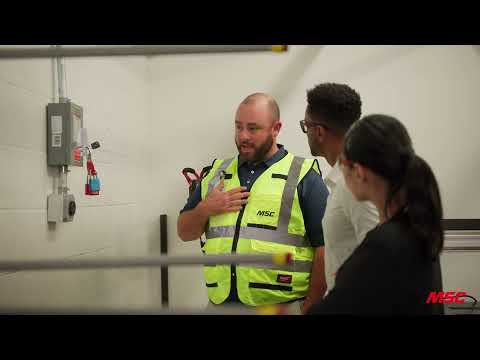A regulation requiring workplaces to protect employees from falls topped the U.S. Occupational Safety and Health Administration’s list of most violated rules for the 14th straight year, prompting nearly $50 million in fines.
While that figure represents a 4.1 percent increase in financial penalties, according to preliminary data for the year through Sept. 30, the number of citations dipped slightly as OSHA prioritized inspections of workplaces where employees perform jobs high above the ground. The data won’t be finalized until after the first week in April.
“Falls are troublesome because they comprise such a large portion of the fatalities that OSHA investigates,” Scott Ketcham, director of enforcement programs, told Safety + Health magazine, a publication of the National Safety Council.
In 2023, the most recent year for which statistics were available, falls accounted for 885 deaths, about 17 percent of all workplace fatalities, according to the U.S. Bureau of Labor Statistics.
“Many workers who experience a fall that doesn’t result in a fatality can suffer a serious, life-altering injury, while others can recover,” Ketcham added. “The more times or the longer a worker works at height without proper fall protection systems in place, the greater the likelihood they will experience a fall.”
To prevent dangerous falls, the agency teams with the National Institute of Occupational Safety and Health, the National Occupational Research Agenda and CPWR-The Center for Construction Research on hazard-awareness programs.
OSHA also organizes the annual National Safety Stand-Down to Prevent Falls in Construction, encouraging businesses each May to talk directly with employees about safety concerns, particularly those related to falls.
While OSHA’s Top 10 most cited standards were the same as in previous years, some ranked differently, and overall citations and fines are both lower than in 2023, according to data compiled so far. The total number of citations fell 3.8 percent to 28,182 while fines dipped less than 1 percent to $131.4 million.
Want to make your workplace safer? Click here to request an MSC safety assessment.
“I’ve been working for OSHA for 30 years, and these cited standards continually repeat,” Ketcham added. “It’s important to put into perspective that these hazards are real, they do lead to fatalities and they are preventable. They’re most commonly cited because, sadly, we’re still finding them in the workplace.”
Here’s a closer look at the 10 most frequently violated OSHA standards in 2024. The rankings include updated figures on citations and penalties as of late December.
Read more: Workplace Falls: 3 Critical Points to Prevent OSHA’s Top Violation
No. 1: Fall Protection
Standard: 1926.501
2024 Citations: 6,763
Change from previous year: -4.5%
2024 Fines: $49.3 million
OSHA imposes a variety of rules to protect workers from on-the-job falls, from requiring precautions such as guardrails on walkways or open floors more than 6 feet above ground to ensuring floor strength and putting covers on holes. Construction companies received 6,615 citations for violating these rules last year, by far the most of any industry, followed by manufacturers, which received 32.
No. 2: Hazard Communication
Standard: 1910.1200
2024 Citations: 3,111
Change from previous year: -3.1%
2024 Fines: $5.08 million
OSHA requires employers to inform workers about the hazards of all chemicals to which they might be exposed on the job, whether they’re produced at a site or simply used there. Along with a hazard communication program, employers are expected to use labels where appropriate, provide safety data sheets and arrange training. Manufacturers received 1,369 citations for violating hazard communication requirements in 2024, outstripping construction.
Read More: 4 Keys to Complying with OSHA’s New Hazard Communication Rule
No. 3: Ladders
Standard: 1926.1053
2024 Citations: 2,764
Change from previous year: -4.8%
2024 Fines: $9.7 million
Portable ladders used in workplaces are generally required to be strong enough to carry at least four times the maximum intended load, according to OSHA; an exception is made for extra-heavy-duty models capable of carrying 300 pounds. With those, the multiple is narrowed to 3.3. OSHA also sets standards for rung spacing, shape and design. As with fall protection, construction firms were given the most citations for failing to comply last year. They received 2,711, followed by manufacturers with at least 15.
Read More: Ladder Safety Tips: What You Need to Know to Protect Your Workers
No. 4: Respiratory Protection
Standard: 1910.134
2024 Citations: 2,690
Change from previous year: +8.6%
2024 Fines: $4.59 million
This rule’s goal is to prevent atmospheric contamination with substances including noxious dust, gases and fumes, if possible, by using less toxic materials, confining or enclosing the operation and providing adequate ventilation, according to OSHA. When those measures are insufficient, employers are required to provide respirators capable of protecting workers from exposure-related hazards. Manufacturers received 1,588 citations, a 32 percent jump from 2023 and the most of any industry. Construction firms received 407.
Read More: 10 Considerations When Choosing Respiratory Protection
No. 5: Lockout/Tagout for Hazardous Energy
Standard: 1910.147
2024 Citations: 2,676
Change from previous year: +4.9%
2024 Fines: $21.5 million
OSHA’s lockout/tagout standard sets procedures for disabling machinery or equipment to prevent release of hazardous energy—including electrical, mechanical, hydraulic, chemical and other types—during service or maintenance. OSHA issued 2,105 citations to manufacturers for violating lockout/tagout rules in 2024, an 11 percent jump from the year before. That placed the field ahead of sectors from waste management to construction and mining.
No. 6: Powered Industrial Trucks
Standard: 1910.178
2024 Citations: 2,437
Change from previous year: -4.7%
2024 Fines: $8.45 million
This rule sets safety guidelines for construction, use and maintenance of workplace vehicles including fork trucks, platform lift trucks and motorized hand trucks—not vehicles used on farms or those intended for over-the-road hauling. Powered industrial trucks are required to meet the design and construction specifications set out in the American National Standard for Powered Industrial Trucks, Part II, ANSI B56.1-1969. Manufacturers were given 1,084 citations for failing to comply with the standard last year, significantly more than fields from construction to transportation and retail.
Read More: What You Need to Know Before Operating Powered Industrial Trucks
No. 7: Fall Protection Training
Standard: 1926.503
2024 Citations: 2,217
Change from previous year: +5.9%
2024 Fines: $4.94 million
Employers are required to provide training on workplace falling hazards as well as safety procedures and equipment from guardrails to safety nets, personal safety harnesses and controlled access zones. Most of OSHA’s fall-protection training citations in 2024 were for construction businesses, which received 2,171 and outpaced fields from waste management to manufacturing, utilities and retail.
No. 8: Scaffolding
Standard: 1926.451
2024 Citations: 1,937
Change from previous year: -30%
2024 Fines: $6.99 million
OSHA standards for scaffolds include requirements that, in most cases, they be sturdy enough to support their own weight plus four times the maximum intended load without collapsing. Specifications are also set for width of walkways, use of guardrails and safety harnesses as well as resistance to tipping over. Construction businesses received 1,843 citations for scaffolding violations, topping industries from manufacturing to real estate and entertainment.
No. 9: Eye and Face Protection
Standard: 1926.102
2024 Citations: 1,912
Change from previous year: -6.2%
2024 Fines: $7.1 million
Employers are required to ensure their workers use appropriate eye or face protection, including masks, goggles and safety glasses, to guard themselves from hazards such as flying particles, molten metals, acids or caustic liquids and chemical gases. OSHA’s rule includes provisions governing prescription lenses, cleaning, disinfecting and comfort. The construction industry received 1,887 citations for violating eye- and face-protection rules last year, outstripping fields from waste management to manufacturing.
No. 10: Machine Guarding
Standard: 1910.212
2024 Citations: 1,675
Change from previous year: +2.4%
2024 Fines: $13.7 million
Federal regulations require use of machine guards such as barriers, two-hand activation controls and electronic safety devices to protect operators of potentially hazardous equipment as well as people nearby.
Read More: High Frequency and High Risk: Protecting Workers from Pinch-Point Hazards
Risks include flying chips, sparks and nip points created when parts move toward each other or past a stationary object where they could trap limbs, causing injuries from bruising to cuts and even amputation. OSHA issued 1,358 citations to American manufacturers last year, a 3.8 percent increase from 2023.








